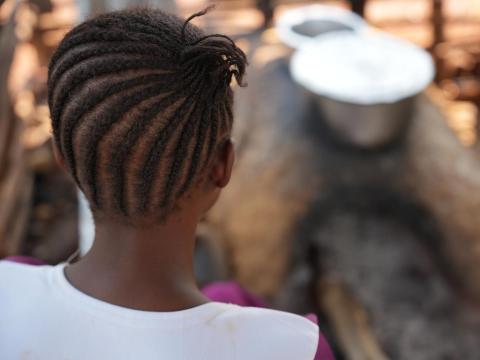DR Congo: After the Massacre, The long Road to Recovery for an Orphan

By Rodrigue Harakandi, Communications Coordinator
In eastern DRC, time is not measured in hours, but in stories of massacres. Communities live to the rhythm of incursions, collective mourning, and resilience that is tested daily. Behind the numbers and reports are voices, faces, and stories that illustrate a tragedy that seems endless. That of 17-year-old Anita is one of them.
The day of the Massacre.
Everything changed one morning around 7 a.m. As she was about to meet up with her family, Anita came across a girl on the road who told her the unthinkable: armed men had taken her parents and all the villagers they had encountered hostage. Forced to turn back, she waited, paralyzed with fear.
The dreaded news came around 3 p.m. The village had been the scene of a massacre.
“We went to collect their bodies, their heads cut off with machetes,” she says, her voice filled with pain that transcends words.
Among the victims were her father, mother, and uncle.
Months later, her little sister, Jeanine, who was present during the scene, is still missing. A friend who was kidnapped at the same time managed to escape.
"She told us that they were reduced to slavery: cooking, carrying the luggage of these armed men. She took advantage of a trip to fetch water from the river to escape," explains Anita, leaving us with unbearable anxiety about her sister's fate.
The young girl then sank into despair.
"After my family disappeared, I lost myself in an abyss of despair and bitterness. The nostalgia for our shared memories pierces my heart. "
“It has become part of everyday life for people around here,” the teenager notes bitterly, summing up the banal horror that has struck the region.
Faith on the Front Line: Pastor Mayani's Account
Anita's account is echoed in tragic detail by Pastor Mayani of the 8th CEPAC, who knew the family well. Anita's father was also a pastor.
On that day, the terrorists demanded that Anita's father bring them a hen and a mat. After a ritual, they gathered 17 people. Before executing them with machetes, they questioned the pastor:
“Are you truly a believer? Are you ready to die for your faith?” Each time, he answered “yes.”
They asked him to pray one last time. After the prayer, they beheaded him and the 16 others.
“Every day, people go through heartbreaking situations that plunge us into despair because of the repeated killings,” says Pastor Mayani.
The Long Road to Recovery: Psychological and Spiritual Support
Today, Anita finds refuge from the chaos in the Church. “I draw comfort from God, the greatest comforter. I place my hope in Him and bless His servants who, every day, through their emotional support, help me prevent this pain from destroying me.”
Pastor Mayani learned how to provide this crucial support through World Vision training.
“Thanks to the expertise shared by World Vision, I was able to closely accompany Anita, strengthen her internally, and bring her back to school so she could build a future for herself,” he says.
His mission is a delicate one: “My role is to help her come to terms with the unacceptable, by making her understand that her ultimate refuge lies in Christ. Nothing can ever replace her family.”
World Vision Trains Guardians of Resilience
Through its “Let The Children Come” (LCC) project, World Vision has trained 98 pairs of religious leaders to become first responders capable of healing the wounds of the soul. These trainings teach deep trauma management, conflict resolution, and the urgent need to break down doctrinal barriers for a united community response.
“I am grateful to World Vision for equipping us, as pastors, to know how to heal wounded souls, those most affected by killings and terror,” concludes Pastor Mayani.
Anita's story is one among many, a stark reminder of the horror of this conflict, but also a tribute to the resilience that comes from caring and competent psychological and spiritual support.
For her protection and dignity, her real name has been changed